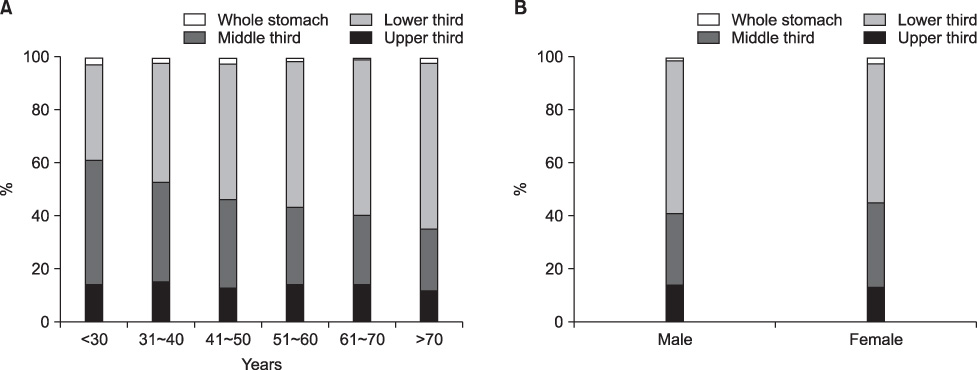J Gastric Cancer.
2011 Jun;11(2):69-77.
Clinicopathological Features and Surgical Treatment of Gastric Cancer in South Korea: The Results of 2009 Nationwide Survey on Surgically Treated Gastric Cancer Patients
- Affiliations
-
- 1Department of Surgery, Chonnam National University Hwasun Hospital, Hwasun, Korea. parkyk@jnu.ac.kr
Abstract
- PURPOSE
In an effort to examine the clinicopathological characteristics of GC and the status of its surgical treatment, the Korean Gastric Cancer Association (KGCA) conducted a nationwide survey targeting surgically-treated gastric cancer patients in 2009.
MATERIALS AND METHODS
A standardized electrical case report was sent to every member institution of the KGCA via E-mail with detailed instructions regarding the survey data. Completed data forms were retrieved from each institution and analyzed by the KGCA information committee.
RESULTS
Data on 14,658 patients was collected from 59 institutions. The mean patient age was 59.2+/-11.9 years with a male to female ratio of 2.05 : 1. Lower third cancer (56.0%) was the most common among all gastric cancers. The histological type revealed poorly differentiated adenocarcinoma (34.1%) to be the most common, and the Lauren classification revealed the intestinal type (50.0%) to be the most prevalent. Curative surgery was performed in 92.4% of patients with laparoscopic surgery in 25.8% of patients. A Billroth I reconstruction was performed most frequently after a distal gastrectomy (63.4% of distal gastrectomy). T1 cancers accounted for 57.6% of all cases, and 62.6% of patients showed no lymph node metastasis. Compared to previous reports, it was found that patients are becoming older, laparoscopic surgery is being performed increasingly, and the proportion of T1 cancer is increasing with time.
CONCLUSIONS
This survey presented the clinicopathological characteristics and current status of the surgical treatment of gastric cancer in Korea. This survey is expected aid research studies as well as planning and evaluation programs targeting cancer control.
MeSH Terms
Figure
Reference
-
1. Parkin DM, Ferlay J, Curado MP, Bray F, Edwards B, Shin HR, et al. Fifty years of cancer incidence: CI5 I-IX. Int J Cancer. 2010. 127:2918–2927.
Article2. Ferlay J, Shin HR, Bray F, Forman D, Mathers C, Parkin DM. Estimates of worldwide burden of cancer in 2008: GLOBOCAN 2008. Int J Cancer. 2010. 127:2893–2917.
Article3. Jung KW, Park S, Kong HJ, Won YJ, Boo YK, Shin HR, et al. Cancer statistics in Korea: incidence, mortality and survival in 2006-2007. J Korean Med Sci. 2010. 25:1113–1321.
Article4. Korea Gastric Cancer Association. Nationwide Gastric Cancer Report in Korea. J Korean Gastric Cancer Assoc. 2002. 2:105–114.5. The Information Committee of the Korean Gastric Cancer Association. 2004 Nationwide Gastric Cancer Report in Korea. J Korean Gastric Cancer Assoc. 2007. 7:47–54.6. http://www.kgca-i.or.kr/. Accessed January 1, 2011.7. Sobin LH, Wittekind C. TNM Classification of Malignant Tumours (UICC). 2002. 6th ed. New York: Wiley-Liss.8. Jemal A, Siegel R, Ward E, Hao Y, Xu J, Murray T, et al. Cancer statistics, 2008. CA Cancer J Clin. 2008. 58:71–96.
Article9. http://www.cancer.go.kr/. Accessed Jan 1, 2011.10. Park CH, Song KY, Kim SN. Treatment results for gastric cancer surgery: 12 years' experience at a single institute in Korea. Eur J Surg Oncol. 2008. 34:36–41.
Article11. Ahn HS, Lee HJ, Yoo MW, Jeong SH, Park DJ, Kim HH, et al. Changes in clinicopathological features and survival after gastrectomy for gastric cancer over a 20-year period. Br J Surg. 2011. 98:255–260.
Article12. Maehara Y, Kakeji Y, Oda S, Takahashi I, Akazawa K, Sugimachi K. Time trends of surgical treatment and the prognosis for Japanese patients with gastric cancer. Br J Cancer. 2000. 83:986–991.
Article13. Borch K, Jönsson B, Tarpila E, Franzén T, Berglund J, Kullman E, et al. Changing pattern of histological type, location, stage and outcome of surgical treatment of gastric carcinoma. Br J Surg. 2000. 87:618–626.
Article14. Jeong O, Park YK, Ryu SY, Kim YJ. Effect of age on surgical outcomes of extended gastrectomy with D2 lymph node dissection in gastric carcinoma: prospective cohort study. Ann Surg Oncol. 2010. 17:1589–1596.
Article15. Choi IJ. Gastric cancer screening and diagnosis. Korean J Gastroenterol. 2009. 54:67–76.
Article16. Roukos DH. Current status and future perspectives in gastric cancer management. Cancer Treat Rev. 2000. 26:243–255.
Article17. Adachi Y, Shiraishi N, Kitano S. Modern treatment of early gastric cancer: review of the Japanese experience. Dig Surg. 2002. 19:333–339.
Article18. Kim YW, Baik YH, Yun YH, Nam BH, Kim DH, Choi IJ, et al. Improved quality of life outcomes after laparoscopy-assisted distal gastrectomy for early gastric cancer: results of a prospective randomized clinical trial. Ann Surg. 2008. 248:721–727.
Article19. Gotoda T. Endoscopic resection of early gastric cancer. Gastric Cancer. 2007. 10:1–11.
Article20. Corley DA, Buffler PA. Oesophageal and gastric cardia adenocarcinomas: analysis of regional variation using the Cancer Incidence in Five Continents database. Int J Epidemiol. 2001. 30:1415–1425.
Article21. Lee JY, Kim HY, Kim KH, Jang HJ, Kim JB, Lee JH, et al. No changing trends in incidence of gastric cardia cancer in Korea. J Korean Med Sci. 2003. 18:53–57.
Article22. Eguchi T, Takahashi Y, Yamagata M, Kasahara M, Fujii M. Gastric cancer in young patients. J Am Coll Surg. 1999. 188:22–26.
Article23. Kim DY, Ryu SY, Kim YJ, Kim SK. Clinicopathological characteristics of gastric carcinoma in young patients. Langenbecks Arch Surg. 2003. 388:245–249.
Article24. Nakajima T. Gastric cancer treatment guidelines in Japan. Gastric Cancer. 2002. 5:1–5.
Article25. Piessen G, Triboulet JP, Mariette C. Reconstruction after gastrectomy: which technique is best? J Visc Surg. 2010. 147:e273–e283.
Article
- Full Text Links
- Actions
-
Cited
- CITED
-
- Close
- Share
- Similar articles
-
- Korean Gastric Cancer AssociationLed Nationwide Survey on Surgically Treated Gastric Cancers in 2019
- Erratum: Korean Gastric Cancer Association-Led Nationwide Survey on Surgically Treated Gastric Cancers in 2023
- Corrigendum: Korean Gastric Cancer Association Nationwide Survey on Gastric Cancer in 2014
- Screening of gastric cancer
- Korean Gastric Cancer AssociationLed Nationwide Survey on Surgically Treated Gastric Cancers in 2023




